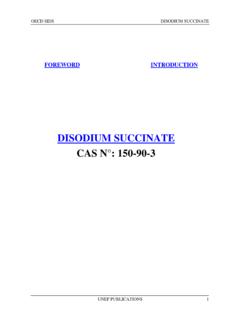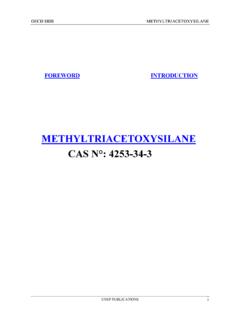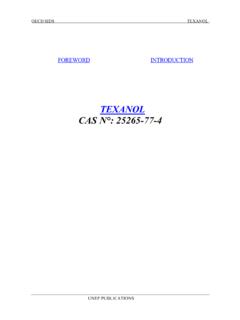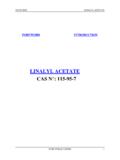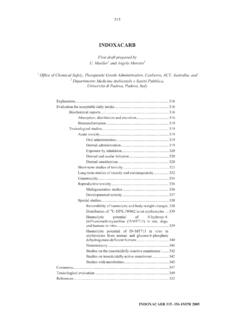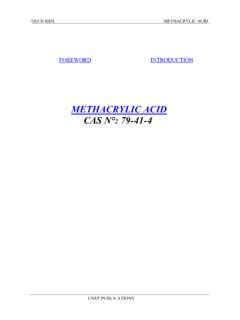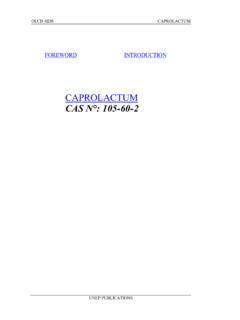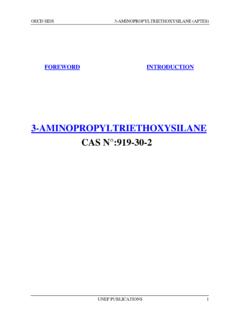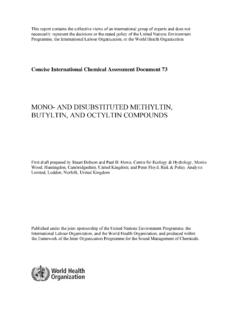Transcription of FOREWORD INTRODUCTION - INCHEM
1 OECD SIDSSULFURIC ACIDUNEP PUBLICATIONSFOREWORDINTRODUCTIONSULFURIC ACIDCAS N : 7664-93-9 OECD SIDS SULFURIC ACID UNEP Publications 90 SIDS Initial Assessment Report for11th SIAM (Orlando, Florida, 23-26 January, 2001) Chemical Name : Sulfuric acid CAS no: 7664-93-9 Sponsor Country : France National SIDS Contact Point in Sponsor Country: Mme. Laurence Musset Bureau des substances et pr parations Minist re de l'environnement 20 avenue de S gur75302 Paris 07 SPFranceHistory: The national peer review consisted of a presentation and critical discussion at a national panel of experts in toxicology and ecotoxicology from administration, university and industry and nominated by the ministry of environment.
2 In parallel, a review was performed by the national institute on environmental and industrial risk (INERIS) by request from the ministry of environment. For this particular substance, only the verification of the most relevant underlying study reports or publications was performed. Testing completed : none Comments: OECD SIDS SULFURIC ACID UNEP Publications 91 SIDS INITIAL ASSESSMENT PROFILE CAS Name Sulfuric acid Structural Formula H2SO4 RECOMMENDATIONSThe chemical is a candidate for further work.
3 SUMMARY CONCLUSIONS OF THE SIARH uman Health The LC50 values for sulfuric acid aerosol observed in acute inhalation studies conducted in different species are low and are most likely due to the corrosive/irritant effect of this chemical. For guinea pigs, the LC50 (8 hours; particle size approximately 1 m) ranges from to mg/l, depending on the age of the animals. Depending on the duration of exposure, the LC50 ranges from to mg/l in rats, to mg/l in mice and to mg/l in rabbits. Only one acute oral toxicity study was available.
4 This study indicated an LD50 of 2140 mg/kg in the acid is corrosive to the skin, eyes and mucous membranes. 10% solutions of sulfuric acid appear not to be irritating to the skin in difference species. Conflicting results (not irritating or severely irritating) are observed in eye irritation studies using 10% sulfuric acid, depending on the protocol used (OECD/EU or US). Sulfuric acid is not considered as an allergen by skin contact in humans. In numerous repeated inhalation studies with sulfuric acid aerosol, toxicity was confined to changes in the structure and function of the respiratory tract, suggesting that it has a local effect and no systemic effects.
5 The observed changes are related to the irritant properties of sulfuric acid and are most likely due to the H+ ion. In a 28-day inhalation study in the rat exposed to sulfuric acid aerosol, minimal squamous metaplasia was observed in the laryngeal epithelium following exposure to the lowest concentration used ( mg/m3). This effect was fully reversible. Exposure to mg/m3 caused more severe metaplasia accompanied by cell proliferation. Sulfuric acid has been shown to be without effect in genetic toxicity studies in vitro (bacterial test).
6 It has been shown to cause chromosomal aberrations in a non-bacterial test in vitro. The chromosomal effects are well known to be a consequence of reduced pH, being seen using any strong acid. There are no in-vivomutagenicity studies available. No carcinogenic effect was observed in carcinogenicity studies conducted by inhalation with sulfuric acid aerosol using 3 different animal species. Small increases in tumor incidence were reported in rats and mice after chronic gastric intubation or intratracheal instillation of sulfuric acid solution, but no clear conclusion can be drawn from these studies.
7 Several epidemiological studies have suggested a relationship between exposure to inorganic acid mists containing sulfuric acid and an increased incidence of laryngeal cancer. IARC has concluded that occupational exposure to strong inorganic mists containing sulfuric acid is carcinogenic for humans (Group OECD SIDS SULFURIC ACID UNEP Publications 921). Concerns have been raised that confounding factors could not be fully excluded. Because sulfuric acid is a direct-acting toxicant, and because it is unlikely to reach the reproductive organs, reproductive effects in mammals are not likely to occur following exposure to sulfuric acid by any route.
8 In a developmental toxicity/teratogenicity study conducted by inhalation with sulfuric acid aerosol, the NOAEL for maternal toxicity appears to be 20 mg/m3 in mice and rabbits. No evidence of foetotoxicity or teratogenicity was seen in either species. Environment Sulfuric acid is a strong mineral acid that dissociates readily in water to sulfate ions and hydrated protons, and is totally miscible with water. Its pKa is at 25 C. At pH , for example, the dissociation is 99 %, and sulfate ion concentration is x 10-4 moles = mg/l.
9 So at environmentally relevant concentrations, sulfuric acid is practically totally dissociated, sulfate is at natural concentrations and any possible effects are due to acidification. This total ionisation will imply also that sulfuric acid, itself, will not adsorb on particulate matters or surfaces and will not accumulate in living tissues. The NOECs selected were obtained on a natural (cold water) lake artificially contaminated by the controlled addition of sulfuric acid: xNOEC in phytoplankton community structure = pH = mg/l sulfuric acid xNOEC in zooplankton population repartition = pH = mg/l sulfuric acid.
10 XNOEC in fish population recruitment = pH = mg/l sulfuric acid There is only one validated NOEC available for warm water fish (Jordanella floridae), mg/l, which is derived from the LOEC/2. ExposureEstimated worldwide production of sulfuric acid is 160 million ton/year. The main uses are non dispersive (industrial uses). In some countries, sulfuric acid is approved for agricultural use. The occurrence of sulfuric acid in the environment comes mainly from the hydrolysis of sulfur oxides produced by combustion processes (natural and anthropogenic), wet deposition, generally as a mixture with nitrogen oxides and nitric acid and not from the manufacturing and use of the acid.
